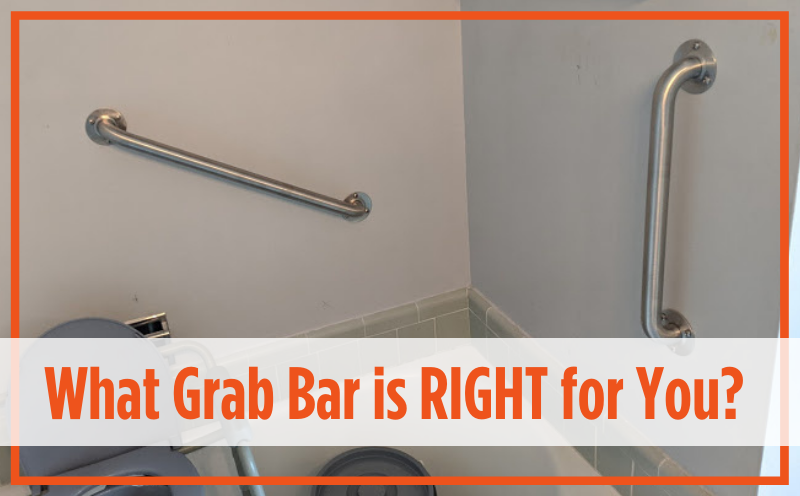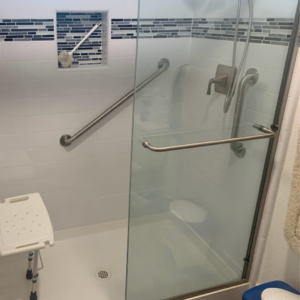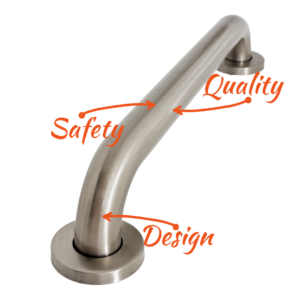
What are Grab Bars?
The name speaks for itself. Grab bars are one of the basic safety features that should be part of our home. They help a person maintain balance, provide support while trying to sit, stand, and move around, and prevent slips and falls.
Towel bars and toilet paper holders are NOT grab bars. Many people use towel bars as grab bars, which is one of the most common and risky mistakes one could make. Yes, they are bars, but they do not have the “grab” part attached to them. They are not designed to hold that much weight. On the other hand, common grab bars can support up to 250 poundswhile heavy-duty grab bars can support up to 500 pounds .
If you do want a grab bar and a towel bar together, designers have made life better for you! Grab bars have evolved to cater to your needs. You can now find grab bars with a variety of inclusion:
- grab bars with towel bar
- grab bars with toilet paper holder
- grab bars with soap dish
- grab bars with shelf
Types of Grab Bars
- Wall-Mount Grab Bars are the most commonly seen and probably the most complicated type. They are mounted in studs or wall anchors. They are more expensive than the other types of grab bars but they offer the greatest durability and security.
- Suction Grab Bars are usually made from plastic materials. They are not predictably safe. They Come with two suction cups on both ends which can be attached to walls. Suction grab bars are budget-friendly, hassle-free, and can be relocated. On the downside, however, they lose their grip which is a red flag. Also, they can only be attached to smooth, flat, and dry surfaces, and they are less sturdy than their counterparts. Suction grab bars often come with the warning: “Use for stability only. Not intended to support full body weight.”
- Bathtub Grab Bar Clamps are adjustable clamp bars used to provide stability when getting in and out of the tub. They can be for short-term or long-term use. When intended for long-term use, make sure to check the clamping mechanism periodically to avoid accidents.
- Flip in/Flip Out is a type of curved grab bar that can be folded to save space. Some models can be attached to walls while others have legs that extend to the floor for added balance.
- Swing Up are hinged grab bars that swing up the bar in a vertical position when not in use to avoid collapse. They are used to increase accessibility among people with mobility issues and disabilities.
- Transfer poles are free-standing floor-to-ceiling bars used as a handhold when stepping in and out of the bathtub, shower, toilet, bed, or couch. The pole is held by tension and does not require formal installation.
- Corner Grab Bars come as an L-shaped bar or a curved bar. These are positioned between two walls and can provide additional support for mobility.
- Angled Grab Bars are similar to corner grab bars, the only difference is that they are attached to one wall. Its 90 degrees design provides both vertical and horizontal handholds.
Choosing the Right Grab Bar for Your Needs
Mounting/Installation
 Grab bars are only as secure as their mounting. So make sure to consider your personal circumstances, the purpose of the installation, and other factors that might affect your safety before deciding which grab bar will work for you.
Grab bars are only as secure as their mounting. So make sure to consider your personal circumstances, the purpose of the installation, and other factors that might affect your safety before deciding which grab bar will work for you.
There are no-drill technology grab bars that allow for easier installation. Since they are temporary, you can transfer them anytime, depending on the necessity. However, caution is needed for this type since the adhesives used can wear out over time and may cause accidents. Strictly follow the instructions provided by the manufacturer and schedule a routine check-up to make sure the grab bar is working well. Most importantly, only purchase quality grab bars. Remember, your safety is the main reason you are buying.
Wall-mounted grab bars are installed on studs, often by expert contractors. The process is a bit complicated and is often placed permanently. However, this type of installation provides the highest level of safety, especially for aging patients and persons with disabilities.
Style
- Straight Grab Bars are versatile. They can be installed vertically, horizontally, or diagonally anywhere in the house. They offer classic and elegant designs for added aesthetics.
- Wave Grab Bars are a playful alternative to straight grab bars both for function and artistic purposes.
Material and Surface Texture
 The type of material to choose from depends on where they are placed. For example, in wet places like the bathroom, you may choose grab bars that are slip-resistant, waterproof, and do not rust.
The type of material to choose from depends on where they are placed. For example, in wet places like the bathroom, you may choose grab bars that are slip-resistant, waterproof, and do not rust.
It is important to remember, however, that whatever material you choose, the key to a lasting grab bar is proper and regular maintenance.
- Stainless Steel grab bars are ideal for long-term use as they do not rust or corrode easily.
- Plastic/Epoxy grab bars may be a good option for those that are not fond of metallic materials.
- Textured grab bars provide a better grip. They often come with grip pads, are peened or diamond brushed.
Location
There is no limit to where grab bars can be placed. Depending on the need, grab bars can be installed in strategic locations around the house.
Length
varies depending on the location the gab bars will be placed. Common grab bars range from 12 inches to 48 inches. It is best to work with a contractor if you are unsure of the appropriate length because they are more equipped and will be able to follow the International Code Council Standard requirements.
Cost
Buy for safety and not the price. You will never go wrong with the right priorities and this will save you much much more in the long run. Just be patient and you’ll find good deals.
We all want safety and security for our loved ones. In every way we can, we make sure they live a quality life.
Grab bars are the simplest element of safety everyone should consider. It is a small investment with a big return.
Sometimes, “I love you” can be said without words. Express your earnest wish for your loved one’s safety with grab bars!
Recent Comments